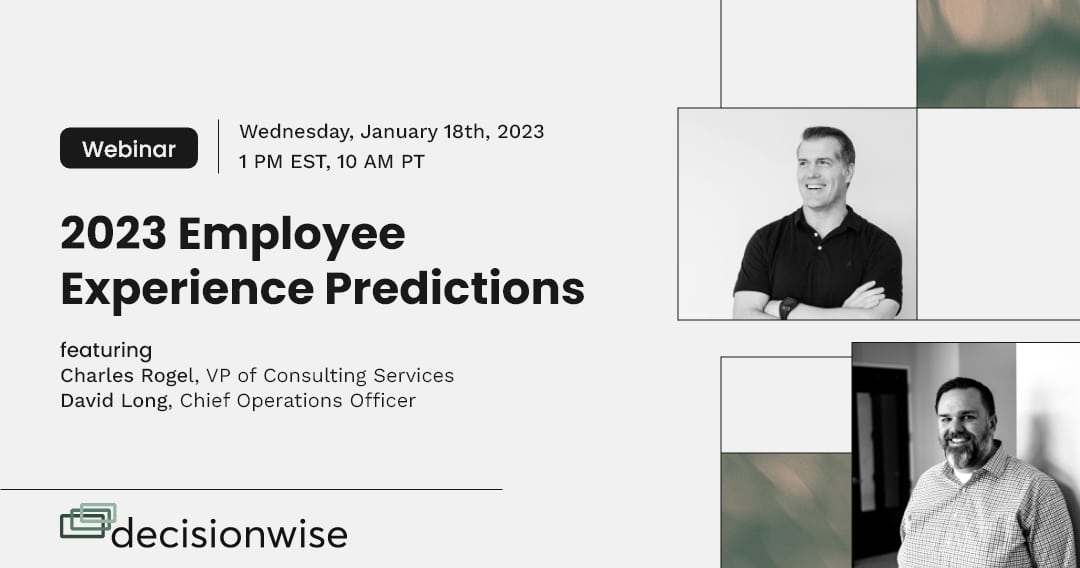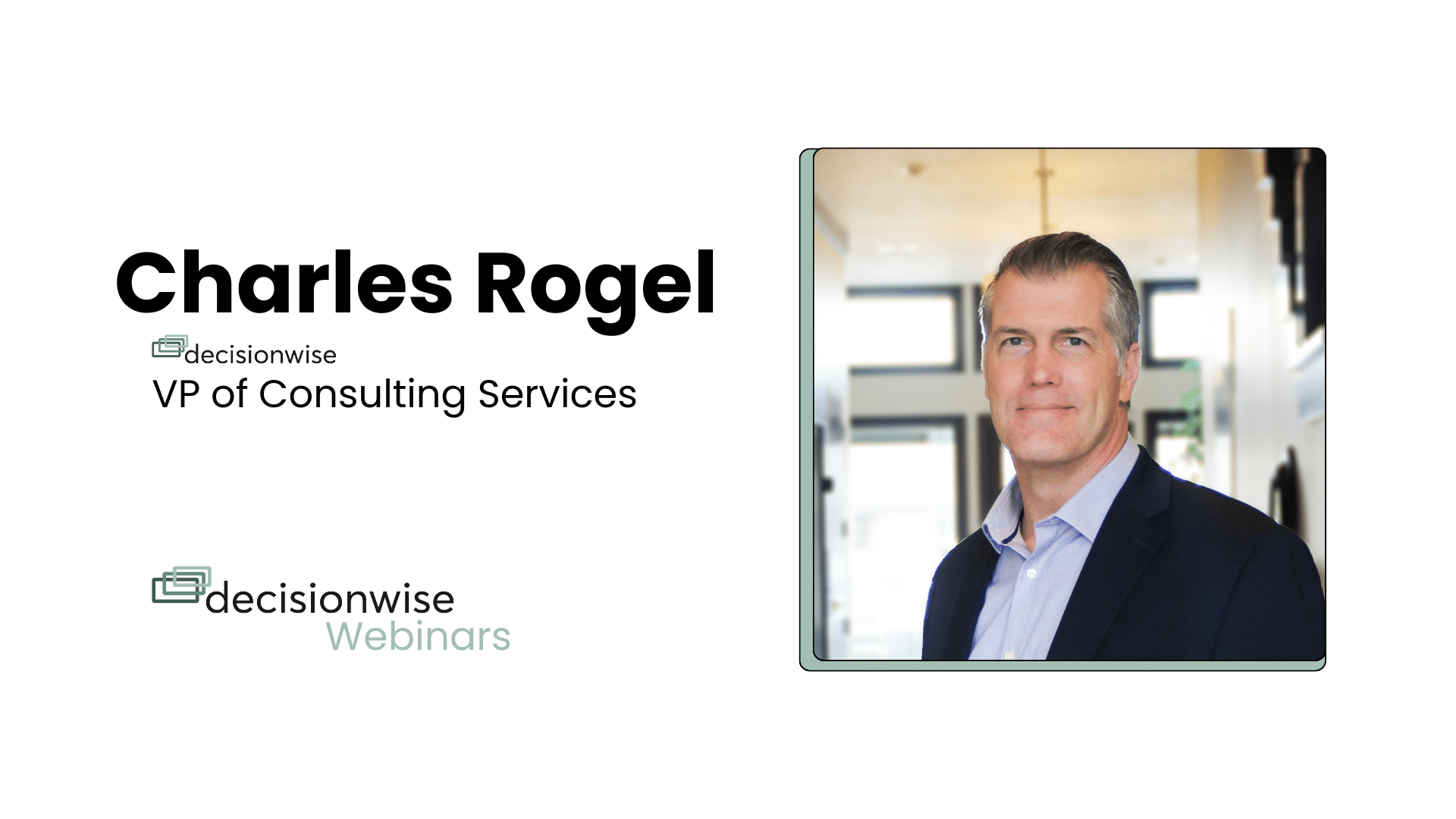What You Might Have Missed From DecisionWise
- Check out this recent article written by DecisionWise CEO, Tracy Maylett “Giving Feedback to Someone Who Lacks Self-Awareness”
- We gathered as a whole company and celebrated Christmas with an amazing dinner, a live band, some fun trivia and a song. Check it out here.
- MasterControl uses Spectiv by DecisionWise and has seen some incredible success. Read more about it in the MasterControl Case Study.
- 2022 taught all of us a lot! We’ve recorded this video What We Learned About Employee Experience in 2022 for you!
- Ever been curious about Spectiv by DecisionWise? Looking to refresh your understanding of the survey platform? Here’s a quick start video guide to Spectiv.
- 2022 was a great year for DecisionWise! See the 2022 year-in-review pics!
JANUARY WEBINAR
Stay up to date on the latest employee experience trends.
The makeup of the workforce has changed quite dramatically over the last few years, and 2023 will be no exception.
Join DecisionWise COO, David Long, and VP of Consulting Services, Charles Rogel, as they provide predictions on what to expect and plan for in 2023 as it relates to employee experience.
This event is free and qualifies for SHRM and HRCI credit
Featured Discussion
Post-2020, and at the peak of The Great Resignation, DecisionWise began to field questions from the C-Suite that we had, until that time, been asked only infrequently. The questions were rooted in variations of the following concern: “As an organization, we have gone to extraordinary efforts over the past few years to ‘get people engaged,’ but we aren’t seeing the results or our efforts. WHY?”
DecisionWise CEO, Dr. Tracy Maylett, along with award-winning journalist and author, Tim Vandehey, set out to answer that question. In their soon-to-be released book Swipe: The Science Behind Why We Don’t Finish What We Start, Maylett and Vandehey reviewed nearly 50 million employee survey responses to understand why, even if companies are successful in creating stellar working environments, people choose to disengage. Why is it that employees, keen to start their first day on a fantastic new job, give up and disengage? Current labor statistics and the “Great Resignation” seem to point to this trend.
Borrowing a term from the world of dating apps, they call this disengagement Swiping, referring to the act of “swiping away” or disengaging from whatever is in front of oneself toward “the next new thing.” In conducting studies for the book, these researchers found something most C-suite and HR execs won’t want to hear (we want to resolve the problem!), but instinctively know:
Engagement is a fifty-fifty proposition. The organization has a responsibility to create the environment in which employees can choose to engage, but engagement is a choice—the employee’s choice.
After all an organization does to create an engaging culture, the employee ultimately decides whether he or she will engage.
DecisionWise research shows that tweaks made at the HR or company levels certainly help, but aren’t the deciding factor as to whether an employee chooses to disengage or to “Swipe.” What about managers? You have likely heard the phrase, “People join companies but leave managers.” So, is it the manager’s fault? Our DecisionWise extensive database of employee survey responses supports the “quit managers” concept – to an extent. When employees hold negative perceptions of their managers, they will leave an organization 56 percent more frequently than employees who hold their manager in high esteem. Further, when a manager is fully engaged at work, 87 percent more of that manager’s direct reports are fully engaged than in an organization in which the manager isn’t fully engaged. So, yes, managers make a big difference.
But remember our fifty/fifty proposition. All managers can do is to create the right invitation to engage. The rest is up to the employee.
Social media titan Meta found that its employees were, indeed, more likely to quit when working under a bad boss. However, most respondents to their study indicated they had good bosses overall. The decision to leave the organization was because they didn’t like the work, not the boss.
When Meta’s people analytics team reviewed employee survey data to predict who would stay or who would leave their jobs over the next six months, they learned something important. Those likely to remain found their work enjoyable 31 percent more often, said the work used their strengths 33 percent more often, and expressed 37 percent more confidence that they were gaining skills that would help them in their future careers than the folks who left. [i]
Managers play a huge role in designing experiences that build from these statistics. And, yes, those corporate employee engagement efforts help. But their role is to till the soil and lay down the nutrients that allow people the opportunity to put down roots – they create that compelling invitation to engage. Successful companies—and successful managers—dig deep to find out what type of culture or environment they are creating. They know that a bad company culture (or a bad manager) will undoubtedly result in employees turning their attention elsewhere.
But the rest of the equation rests squarely on the employee. Ultimately, engagement is a choice. An employee’s choice. Swipe helps managers and employees understand how to make this vital choice to engage. When we add this final element – the employee’s decision to engage – everyone is doing their part: the organization, the manager, and the employee.
Pre-order your copy of Swipe: The Science Behind Why We Don’t Finish What We Start, which will be released March 20, 2023
[i] Goler, L., Gale, J., Harrington, B., and Grant, A. (2018, January 11). “Why people really quit their jobs.” Harvard Business Review.






